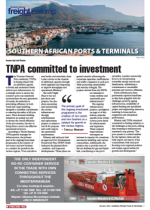The Namibian port of Walvis Bay is positioning itself to become the port of choice for its neighbours, which include Botswana, Zambia and the Democratic Republic of Congo (DRC).In 2023, The Namibian Ports Authority (Namport) said the total cargo handled had increased by 17% to 7 691 781 million tonnes compared to 6 576 370 million tonnes in 2022.Namport attributes the increase to market demand, the allocation of additional fishing quotas and the expansion of mining activities in the region.Cross-border volumes involving its neighbours grew 41% to 2 263 362 tonnes (2022: 1 606 984 tonnes), representing 29% of total cargo volumes handled by the author it y.The total cross-border volumes comprised 782 184 tonnes destined for the hinterland and 1 481 178 tonnes from the hinterland.Namport says key markets such as South Africa, Zambia, the DRC and Botswana contributed to the phenomenal growth in cross-border volumes.According to the ports author it y, Botswana experienced a significant increase. This was driven by coal and copper concentrate exports and fuel imports, highlighting the importance of the logistics hub concept for sustained growth.Namport handles local and cross-border cargo imports and exports through the four main trade corridors: the Trans-Kalahari Corridor that runs through Namibia, Botswana and South Africa; the Walvis Bay-Ndola-Lubumbashi Corridor that runs through Namibia, Zambia and the DRC; the Trans-Cunene Corridor that runs between Namibia and Angola; and the Trans-Oranje Corridor between Namibia and South Africa.Namport says it is facing competition from the Port of Lobito in Angola as an alternative gateway for landlocked countries such as the DRC and Zambia.The Lobito corridor is being lined up for some $250 million in financing from the United States Development Finance Corporation.According to the Walvis Bay Corridor Group, a public-private partnership has been established to promote the utilisation of Namibian ports, and in the 2022/23 financial year, the best performance was shown by the Botswana market with a growth of 285%. This was mainly due to new commodities introduced such as sugar imports from Brazil, and coal and copper concentrate exports.The South African market grew by 42%, from 771 852 tonnes to 1 093 569 tonnes. This market is mainly driven by manganese exports from the Hotazel area near Upington in the Northern Cape through the port of Lüderitz.In addition, the DRC and Zambian markets have grown exponentially by 33% and 40%, respectively, from 243 029 tonnes to 324 151 tonnes and 363 621 tonnes to 510 323 tonnes for both markets.

